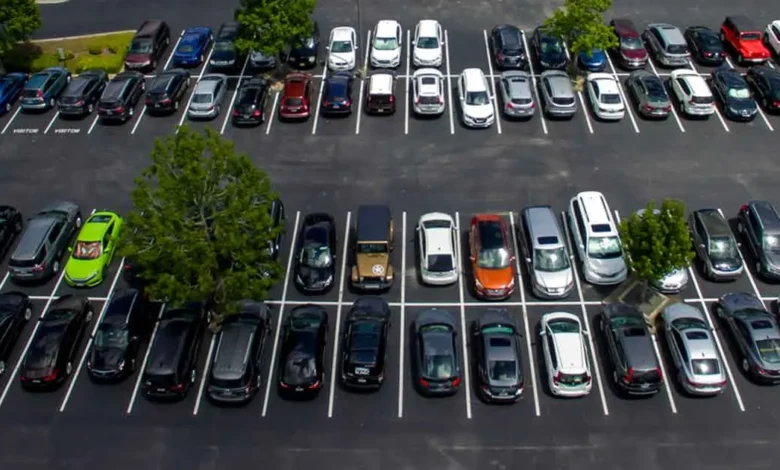VRR Parking: Revolutionizing the Future of Vehicle Storage and Mobility

In an age where urbanization is expanding at an unprecedented pace, parking has become one of the most pressing challenges for cities, businesses, and individuals alike. With millions of vehicles competing for limited space, innovative solutions are essential to ensure efficiency, security, and convenience. Enter VRR Parking — a modern, intelligent approach to vehicle storage that integrates technology, automation, and design to reshape how we think about parking.
This article explores everything about VRR Parking — what it is, how it works, its technology, benefits, and the transformative impact it’s having on modern mobility systems.
1. Understanding VRR Parking
What Is VRR Parking?
VRR Parking refers to an advanced, technology-driven parking system developed to optimize the way vehicles are stored, managed, and retrieved. The acronym “VRR” is commonly associated with concepts like Vehicle Retrieval and Rotation, Vehicle Recognition and Reservation, or Vehicle Return and Recovery — depending on the system’s design and purpose.
At its core, VRR Parking represents a smart parking solution that integrates automation, artificial intelligence (AI), and sensor-based systems to enhance parking efficiency. Whether implemented in large commercial complexes, airports, residential towers, or public infrastructure, VRR Parking ensures maximum utilization of available space while minimizing human error and congestion.
In short, VRR Parking isn’t just a parking lot — it’s a digital ecosystem built for the cities of tomorrow.
2. The Need for Modern Parking Solutions
The Growing Urban Parking Crisis
Urbanization has led to a rapid increase in vehicles. Yet, city infrastructure has not evolved at the same pace. The result? Endless traffic jams, overcrowded streets, wasted fuel, and frustrated drivers.
Statistics show that in many metropolitan areas, drivers spend an average of 15–30 minutes per day searching for parking spaces. This inefficiency not only wastes time but also contributes significantly to carbon emissions and urban stress.
Traditional parking lots are often:
Space-inefficient
Prone to congestion
Vulnerable to theft and vandalism
Difficult to manage without advanced systems
VRR Parking was developed as a solution to these long-standing inefficiencies, merging smart technology and automation to create a seamless experience for both drivers and operators.
3. How VRR Parking Works
The Core Technology
VRR Parking systems operate through a combination of hardware automation and intelligent software management. Let’s break down its components:
a. Vehicle Recognition
When a vehicle arrives, it is scanned using license plate recognition (LPR) or RFID tagging. This allows the system to instantly identify the car, log entry time, and direct it to the nearest available spot without requiring manual intervention.
b. Smart Guidance System
Digital sensors and cameras placed throughout the facility communicate with the central management system. Drivers receive directions via LED indicators or mobile applications guiding them to a vacant spot.
This minimizes traffic within the parking area and eliminates the frustration of circling endlessly in search of a space.
c. Automated Parking Mechanisms
In advanced VRR Parking facilities, vehicles are parked automatically using robotic platforms, conveyor systems, or hydraulic lifts. Once the car is positioned on a designated platform, the system moves it to an optimized storage location — vertically or horizontally — without driver involvement.
This automation drastically reduces space requirements, allowing up to 50% more vehicles to be stored in the same footprint compared to conventional lots.
d. Vehicle Retrieval
When a user is ready to leave, they can request their car via a mobile app, kiosk, or card system. The system automatically retrieves the vehicle from storage, rotates it into a drive-ready position, and delivers it to the pickup bay — hence the term Vehicle Retrieval and Rotation.
e. Payment and Reservation Integration
VRR Parking systems are often integrated with digital payment gateways and reservation platforms, enabling users to pre-book spaces, track usage, and make contactless payments.
This holistic approach simplifies the entire parking experience from entry to exit.
4. Key Features of VRR Parking Systems
VRR Parking offers a wide range of advanced features designed for modern users and urban infrastructure. Some of its standout characteristics include:
1. Space Optimization
Automated stacking and compact vehicle arrangement allow developers to utilize up to twice the space compared to traditional parking structures. This is particularly valuable in high-density areas where land costs are high.
2. Safety and Security
With automated handling and restricted human access, VRR Parking drastically reduces risks of theft, vandalism, and accidents. High-definition cameras, motion sensors, and AI-based surveillance further enhance security.
3. Eco-Friendly Operations
By reducing idling time, congestion, and unnecessary driving within parking facilities, VRR systems contribute to lower carbon emissions. Additionally, some systems use energy-efficient elevators and lighting, supporting sustainable urban design.
4. Contactless Experience
The entire parking process — from reservation to payment — can be managed through smartphones or kiosks. This contactless design aligns perfectly with modern hygiene and convenience standards.
5. High Retrieval Speed
Advanced systems can retrieve a vehicle within 60–120 seconds, significantly faster than the average time it takes to exit a traditional multi-story parking lot.
6. Maintenance and Monitoring
The system continuously monitors mechanical components, occupancy rates, and user patterns, providing real-time data for maintenance scheduling and efficiency analysis.
5. Advantages of VRR Parking
Implementing a VRR Parking system brings benefits to multiple stakeholders — from city planners to individual drivers.
A. For Drivers
Ease of Use: Automated entry and exit reduce stress and save time.
Safety: No human attendants needed; vehicles are secured in restricted zones.
Convenience: Reservation and payment through apps simplify the experience.
Damage Prevention: Automated parking eliminates human error such as dents or scrapes.
B. For Businesses and Developers
Increased Revenue: Higher capacity in smaller spaces means better ROI.
Prestige and Innovation: Implementing high-tech systems adds modern appeal to buildings.
Lower Operational Costs: Minimal staffing requirements and automated management reduce long-term costs.
Data Analytics: Insights on usage trends and customer behavior improve future planning.
C. For Cities and Communities
Reduced Traffic Congestion: Fewer cars roaming for parking spaces.
Environmental Benefits: Lower emissions and more efficient land use.
Smart Infrastructure: Contributes to the vision of Smart Cities that integrate technology into daily life.
6. The Technology Stack Behind VRR Parking
a. Internet of Things (IoT)
IoT sensors play a vital role in VRR Parking systems. They monitor parking spot availability, detect vehicle positions, and transmit real-time data to the control center.
b. Artificial Intelligence and Machine Learning
AI algorithms analyze traffic patterns, predict peak times, and optimize vehicle flow within the parking system. Machine learning enables continuous improvement by learning from user behavior and system performance.
c. Robotics and Automation
Mechanical lifts, conveyors, and turntables physically move vehicles into optimized storage configurations. These robotic systems are programmed for precision and safety.
d. Cloud-Based Management
Cloud infrastructure allows remote access, monitoring, and updates. Operators can view real-time performance dashboards and adjust settings from anywhere.
e. Mobile Integration
Through smartphone apps, users can book parking spots, navigate to locations, pay fees, and request vehicle retrievals. The seamless connection between the physical and digital world makes VRR Parking exceptionally user-friendly.
7. Types of VRR Parking Systems
Not all VRR Parking facilities are identical — they can be tailored to fit different environments and capacities. Here are some of the common types:
1. Tower (Vertical) Parking System
Cars are lifted vertically into storage using elevators and stacked efficiently in multi-level structures. This is ideal for areas with limited horizontal space, such as downtown districts.
2. Puzzle Parking System
In this design, vehicles are arranged in a grid-like structure. The system slides cars horizontally and vertically, moving them like puzzle pieces to access any desired vehicle.
3. Rotary (Carousel) Parking System
Cars are rotated on a circular platform, similar to a Ferris wheel. This compact system is best suited for smaller lots or residential complexes.
4. Shuttle or Pallet-Based Systems
These use robotic shuttles to carry vehicles to available spots without human assistance, often guided by sensors and computer mapping.
Each system offers unique advantages, and the selection depends on factors like available space, expected traffic volume, and installation cost.
8. Implementation and Challenges
While VRR Parking offers immense potential, it’s not without challenges. Implementing such advanced systems requires careful planning and investment.
Challenges Include:
High Initial Setup Costs: The machinery, software, and installation require significant capital.
Maintenance Complexity: Regular servicing and technical expertise are needed to maintain reliability.
User Education: Drivers must adapt to new systems and digital interfaces.
Integration with City Systems: Successful deployment depends on cooperation between government, developers, and tech providers.
However, the long-term benefits in efficiency, space savings, and sustainability often outweigh these hurdles.
9. The Future of VRR Parking
Integration with Smart Cities
As cities worldwide adopt smart mobility initiatives, VRR Parking systems are becoming central to urban planning. By connecting with traffic sensors, navigation apps, and electric vehicle (EV) infrastructure, these systems can become part of a citywide intelligent transport network.
Electric Vehicle Support
Future VRR Parking systems will feature built-in EV charging stations, allowing cars to recharge while parked. Automated charging arms and wireless systems are already being tested.
AI-Driven Optimization
AI will soon allow predictive parking — where systems forecast demand and dynamically adjust pricing or availability. This can help balance traffic across multiple parking sites.
Sustainable Materials and Design
Eco-friendly materials, solar panels, and energy-efficient elevators will make VRR Parking greener and more cost-effective.
Autonomous Vehicle Integration
When self-driving cars become mainstream, VRR Parking will serve as the perfect partner technology. Automated systems can directly communicate with vehicles to park or retrieve them without any human presence.
10. Real-World Impact
The influence of VRR Parking extends far beyond convenience. It represents a shift in how cities manage mobility. By combining technology with practicality, it helps solve several modern challenges simultaneously:
Reduces Land Consumption: Maximizing vertical space.
Encourages Smart Development: Aligning architecture with sustainability goals.
Improves Urban Aesthetics: Eliminating chaotic open lots.
Boosts Accessibility: Guiding drivers directly to available spaces.
Ultimately, VRR Parking is more than a technical innovation — it’s a symbol of progress toward efficient, eco-friendly, and human-centered urban design.
11. Conclusion
The world is changing fast, and with it, the way we move and park our vehicles. VRR Parking stands at the intersection of innovation and necessity — blending automation, artificial intelligence, and environmental consciousness to address one of modern life’s most frustrating problems.
From compact robotic systems to app-based user experiences, VRR Parking demonstrates that parking doesn’t have to be a hassle. It can be intelligent, efficient, and sustainable.
In the coming years, as cities grow smarter and vehicles evolve, systems like VRR Parking will play a crucial role in shaping the mobility ecosystem. They’ll make parking faster, safer, and greener — turning an everyday inconvenience into a seamless experience.
The future of urban living depends on innovations like VRR Parking — where technology meets practicality, and where every space counts.


